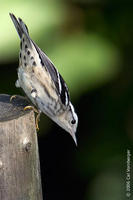|
| Query: large white | Result: 738th of 2106 | |
Image of: Mniotilta varia (black-and-white warbler)

| Resolution: 320x480
File Size: 51915 Bytes
Date: 2006:08:16 08:26:41
Camera: Canon EOS-1D Mark II (Canon)
F number: f/5.6
Exposure: 1/60 sec
Focal Length: 840/1
Upload Date: 2008:05:09 16:11:49
|
|
|

